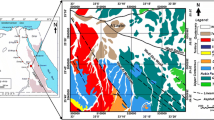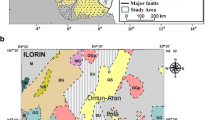Abstract
In the present study, the Bouguer, aeromagnetic, and seismological data analysis for Nile Delta including the Greater Cairo region and its surroundings was used to examine and trace the tectonic framework for some deep-seated faults (mostly normal faults with a small strike–slip component) and their orientation, on which most earthquakes have occurred. The new tilt derivative (TDR) geophysical map and Euler deconvolution presented here can be used to trace the structural relationships and their depth investigations across the entire region. Generally, most of the Euler deconvolution results especially from the gravity map were well coincided with the location of contacts derived by TDR particularly NNW to NS, EW, and NE trended structures. The depths to the gravity or magnetic sources, and the locations of the contacts of density contrast were estimated. Results of the Euler deconvolution method suggested that, in the southeastern part of the area, the basement could be observed to be shallow and has become deeper beneath the northern part. Furthermore, the resulting structural map of this study is well correlated with previous geological and seismological data analyses. At least two sets of predominant faults are suspected, faults with a NNW strike (Clysmic trend) which are particularly felt in the southern portion of the Delta, and some of them give it the shape of a “graben like structure.” Another parallel set of faults, having NE–SW strike (Pelusium trend), was also obvious in the southern part between Cairo and Suez cities (at Abu Zabal area). The evaluated trending faults (NNW–SSE or NE–SW) are intersecting with predominant major WNW–ESE to E–W (Tethys trend) striking faults. These intersections may generate more additional seismic pulses and consequently increase the seismic activity for these structures. However, minor NW (Najd Fault System) is obvious in the TDR magnetic map, whereas less attendance NS (East African trend) structural trends are evident in the TDR gravity map. Moreover, it could be said that the southeastern portion of the Nile Delta (especially the eastern portion of Greater Cairo) is affected by highly tectonic fault systems. Finally, a new tectonic map was also evaluated from the resulting structural map, which helps to quantify different structural patterns (faults and/or contacts), and their relations with the regional tectonic trends are discussed.











Similar content being viewed by others
References
Abd El-AaL AK (2010a) Modeling of seismic hazard at the northeastern part of Greater Cairo metropolitan area, Egypt. J Geophys Eng 7:75–90. doi:10.1088/1742-2132/7/1/007, 2010
Abd El-Aal AK (2010b) Ground motion prediction from nearest seismogenic zones in and around Greater Cairo Area. Egypt Nat Hazards Earth Syst Sci 10:1495–1511. doi:10.5194/nhess-10-1495-2010, www.nat-hazards-earth-syst-sci.net/10/1495/2010/
Abdel Tawab S (1986) Structural analysis of the area around Gebel El Mokattam. M. Sc. Thesis, Geol. Dep. Fac. Sci., Ain Shams Univ. 121 p
Abou Elenean KM (1997) A study of the seismotectonics of Egypt and relation to the Mediterranean and Red Seas tectonics. Ph.D. thesis, Faculty of Science, Ain Shams University, Egypt
Bosworth W, Crevello P, Winn RD Jr, Steinmetz J (1998) Structure, sedimentation, and basin dynamics during rifting of the Gulf of Suez and northwestern Red Sea. In: Purser BH, Bosence DWJ (eds) Sedimentation and tectonics of Rift Basins: Red Sea–Gulf of Aden. Chapman and Hall, London, pp 77–96
Bumby AJ, Guiraud R (2005) The geodynamic setting of the Phanerozoic basins of Africa. J Afr Earth Sci 43(1–3):1–12
Cochran JR, Martinez F (1988) Structure and tectonics of the northern Red Sea: catching a continental margin between rifting and drifting. Tectonophysics 150(1–2):1–32
Egyptian General Petroleum Company (EGPC) (1984) Bouguer anomaly map of Nile Delta, (scale: 1:100,000)
Egyptian General Petroleum Corporation (EGPC) (1983) RTP magnetic anomaly map of Nile Delta (scale: 1:100,000)
Egyptian Geological Survey (1981) Geological map of Nile Delta, Arab Republic of Egypt, (scale 1:500,000)
El-Sayed A, Vaccari PGF (2003) The Nile Valley of Egypt: a major active Graben that magnifies seismic waves. Pure and Applied Geophysics 161(5–6):983–1002. doi:10.1007/s00024-003-2504-z
Fichler C, Rundhovde E, Olesen O, Saether BM, Ruelatten H, Lundin E, Dore AG (1999) Regional tectonic interpretation of image enhanced gravity and magnetic data covering the mid-Norweigian shelf and adjacent mainland. Tectonophysics 306(2):183–197
Grant FS, West GF (1965) Interpretation theory in applied geophysics. McGraw-Hill, New York
Guiraud R, Bosworth W (1999) Phanerozoic geodynamic evolution of northeastern Africa and the northwestern Arabia platform. Tectonophysics 315(1–4):73–108
Hartman RR, Teskey DJ, Friedberg JL (1971) A system for rapid digital aeromagnetic interpretation. Geophys 36:891–918
Kebeasy RM (1990) Seismicity. In geology of Egypt. Baklema, Rotterdam, pp 51–59
Klitgord KD, Behrendt JC (1979) Basin structure of the U.S. Atlantic margin. In: Watkins JS, Montadert L and Dickerson PW (eds) Geological and geophysical investigation of continental margins. American Association of Petroleum Geologists Memoir, 29, Tulsa, OK, 85–112
Longacre, M, Bentham P, Hanbal I, Cotton J, Edwards R (2007) New crustal structure of the Eastern Mediterranean basin: detailed integration and modeling of gravity, magnetic, seismic refraction, and seismic reflection data. EGM Innovation in EM, Gravity and Magnetic Methods: a new Perspective for Exploration, Capri, Italy, April 15–18
Maamoun M, Allam A (1980) A study of the seismicity of the east Mediterranean region, 7th Ann. Meet., EGS-ESC, Budapest
Makris J, Rihm R (1991) Shear-controlled evolution of the Red sea: pull apart model. Tectonophysics 198(2–4):441–466
Meshref WM (1990) Tectonic framework. In: Said R (ed) The geology of Egypt. A.A. Balkema Publishers, Rotterdam, pp 113–156
Milbury AEC, Smrekar SE, Raymond CA, Schubert G (2007) Lithospheric structure in the east region of Mars' dichotomy boundary. Planet Space Sci 55(3):280–288
Moustafa AR (1997) Controls on the development and evolution of transfer zones: the influence of basement structure and sedimentary thickness in the Suez rift and Red Sea. J Struct Geol 19(6):755–768
Naudy H (1971) Automatic determination of depth on aeromagnetic profiles. Geophys 36:717–722
Neev D (1977) The Pelusium Line–a major transcontinental shear. Tectonophysics 38(3–4):T1–T8
Neev D, Almagor G, Arad A, Ginzburg A, Hall JK (1976) The geology of the southeastern Mediterranean sea. Geol Surv Isr Bull 68:51
Neev D, Hall JK, Saul JM (1982) The Pelusium Megashear System across Africa and associated lineament swarms. J Geophys Res 87(B2):1015–1030
Reid AB, Allsop JM, Granser H, Millet AJ, Somerton IW (1990) Magnetic interpretation in three dimensions using Euler deconvolution. Geophys 55:80–91
Said R (1962) The geology of Egypt. Elsevier, Amsterdam
Said R (1981) The Nile river. Springer, Berlin, p 151
Saleh S (2012) 3-D crustal structure and its tectonic implication for Nile Delta and Greater Cairo regions, Egypt, from geophysical data. Acta Geodaetica et Geophysica Hungarica. (In press)
Salem A, Williams S, Fairhead D, Smith R, Ravat D (2008) Interpretation of magnetic data using tilt-angle derivatives. Geophysics 73(1):1–10
Sestini G (1984) Tectonics and sedimentary history of the NE African margin (Egypt-Libya). In: Dixon JD, Robertson AHF (eds) The geological evolution of the Eastern Mediterranean. Blackwell, Oxford, p 151–126
Shata AA, El Fayoumy I (1969) Remarks on the regional geological structure of the Nile Delta. Proc. of Bucharest symposium for hydrology of the Delta
Silva JBC, Barbosa VCF (2003) 3D Euler deconvolution: theoretical basis for automatically selecting good solutions. Geophysics 68(6):1962–1968
Stern RJ (1985) The Najd Fault System, Saudi Arabia and Egypt: a Late Precambrian rift system? Tectonics 4(5):497–511
Thompson DT, EULDEPTH (1982) A new technique for making computer assisted depth from magnetic data. Geophysics 47:31–37
Tingay M, Bentham P, De Feyter A, Kellner A (2011) Present-day stress-field rotations associated with evaporites in the offshore Nile Delta. GSA Bulletin 123(5/6):1171–1180. doi:10.1130/B30185
Verduzco B, Fairhead JD, Green CM, MacKenzie C (2004) New insights into magnetic derivatives for structural mapping. Lead Edge 23:116–119
Werner S (1953) Interpretation of magnetic anomalies of sheet-like bodies: Sveriges Geologiska. Undersökning Årsbok, 43(1949), No. 6
Acknowledgments
I would like to express my gratitude to the General Petroleum Company, Cairo, Egypt, for utilizing the Bouguer, magnetic, and oil well data. I thank also the anonymous reviewers for their thorough critical, and constructive comments that greatly contributed to improving this work.
Author information
Authors and Affiliations
Corresponding author
Rights and permissions
About this article
Cite this article
Saleh, S. The role of geophysical and seismological data in evaluating the subsurface structures and tectonic trends of Nile Delta, Egypt. Arab J Geosci 6, 3201–3216 (2013). https://doi.org/10.1007/s12517-012-0603-9
Received:
Accepted:
Published:
Issue Date:
DOI: https://doi.org/10.1007/s12517-012-0603-9




